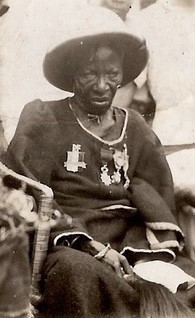Ngalifourou (1864 – 8 June 1956) was a queen of the Mbé region in what is today the Republic of Congo (Congo-Brazzaville). As a ruler she was close to French colonial authorities and was the first ruler in her region to sign a treaty with them.
| Ngalifourou | |
|---|---|
| Queen | |
 | |
| Queen consort | c.1880 - 1892 |
| Queen Mother | 1892 - 1956 |
| Born | 1864 Ngabé |
| Died | 8 June 1956 Ngabé |
| House | Mbe |
| Religion | Teke spiritualism |
Biography edit
Ngalifourou was born in 1864 in Ngabé on the Congo River.[1] A member of the Téké people, who are a Bantu community living between the present-day Democratic Republic of the Congo and the Republic of the Congo, Ngalifourou was married at the age of 15 to King Iloo I (also known as Iloo Makoko), who was much older than her.[1] She was his second wife.[1] Oral traditions suggest they married in 1880.[2]
After their marriage, Ngalifourou upheld the king's authority and gained respect for her intelligence, including from Pierre Savorgnan de Brazza, who was a French colonial army officer who collaborated with her husband.[2] De Brazza presented Ngalifourou with a sabre as a gesture of admiration.[3] In 1944, de Brazza's daughter, Marthe de Brazza, visited Ngalifourou, who showed her the sword and discussed her father with de Brazza.[4] This 'collaboration' between de Brazza, Iloo Makoko and, indeed, Ngalifouroou, was in fact a treaty signed by Iloo Makoko in 1880, which ceded Teke territory to France, thus establishing French Congo.[5]
At the death of King Iloo I in 1892, Ngalifourou ascended to the throne as Man Ounko (Queen Mother) of the Mbé Kingdom.[2] Tradition meant that Ngalifourou needed to marry again, which she did, but she and the new king lived apart, something that was an accepted practice in Téké customs; neither did they have children.[2] She did however, return to live in her birthplace in Ngabé.[6]
Spiritual life edit
Ngalifourou was a spiritual leader as well.[4] She did this through close association with Nkwe Mbali, spirituality associated with the king.[7] Due to her supposed spiritual power, many people made pilgrimages to visit her at Ngabé where she would receive visitors on her likouba royal stool.[2] As a result Ngalifourou was targeted by Catholic and Protestant missionaries who wanted her to adopt one of their faiths, knowing that if she did so it would influence others; however she resisted and continued Téké spiritual practices.[2]
French colonial rule edit
However, Ngalifourou did not retire from public life, but became a prominent figure known to the French colonial administration.[2] She was seen as an example of a traditional ruler, who accepted colonial rule.[2] She signed the first treaty between a traditional ruler and the French.[4] She met General de Gaulle on several occasions, notably in March 1944, when she was presented with the Légion d'honneur medal.[4] To cement her relationship with the French, she encouraged Teké soldiers to join the French military in both the First World War and the Second World War.[2] Such was her relationship with the colonial authorities that some Teké referred to her as "Ngalifourou, the woman of the whites".[2] In the late 1940s and early 1950s, her influence waned as political parties wanted independence from the French grew in popularity.[2]
Ngalifourou died on 8 June 1956.[2] Her funeral became a tool for the French authorities to try and prop up their power and they arranged a huge funeral for the former queen, which was attended not just by local colonial dignitaries, but by representatives from other French colonies, the Vatican and the Belgian Congo.[2] Journalists had been encouraged to stay in Ngabé to report on the queen's final days as well as her funeral.[2]
Awards and honours edit
- Légion d'honneur (1944).[4]
- Order of the Star of the Comoros Island of Anjouan.[2]
- Medal of Overseas Service of Benin.[2]
Legacy edit
The role of Queen Mother is still respected in Teké society and the person in that role bears the name Ngalifourou out of respect for their predecessor.[2] She is also listed by UNESCO as one of the most important women in African History.[3]
Ngalifourou features in the poem Le pardon de l'adieu by Tchicaya U Tam'Si.[8]
Bibliography edit
- La reine Ngalifourou souveraine des Téké - Eugénie Mouayani Opou (2006).[9]
References edit
- ^ a b c "Ngalifourou, dernière souveraine d'Afrique noire". L'Histoire par les femmes (in French). 2016-02-29. Retrieved 2021-01-15.
- ^ a b c d e f g h i j k l m n o p q jeremy, rich (2012), Akyeampong, Emmanuel K; Gates, Henry Louis (eds.), "Ngalifourou", Dictionary of African Biography, Oxford University Press, doi:10.1093/acref/9780195382075.001.0001, ISBN 978-0-19-538207-5, retrieved 2021-01-15
- ^ a b "UNESCO Women in Africa History | Women". en.unesco.org. Retrieved 2021-01-16.
- ^ a b c d e Bernault, Florence (1996-01-01). Démocraties ambiguës en Afrique centrale: Congo-Brazzaville, Gabon, 1940-1965 (in French). KARTHALA Editions. ISBN 978-2-86537-636-0.
- ^ "The man who would be Congo's king". 2003-02-12. Retrieved 2021-01-16.
- ^ dir.), Robert Edmond ZIAVOULA (ss (2006-11-01). Brazzaville, une ville à reconstruire (in French). KARTHALA Editions. ISBN 978-2-8111-4128-8.
- ^ Stroeken, Koen (2018-09-07). Medicinal Rule: A Historical Anthropology of Kingship in East and Central Africa. Berghahn Books. ISBN 978-1-78533-985-1.
- ^ Tam'Si, Tchicaya U (1960). "Le pardon de l'adieu". Présence Africaine (30): 74–76. ISSN 0032-7638. JSTOR 24345380.
- ^ Opou, Eugénie Mouayani (2006-09-15). La reine Ngalifourou souveraine des Téké (in French). Editions L'Harmattan. ISBN 978-2-296-15515-2.